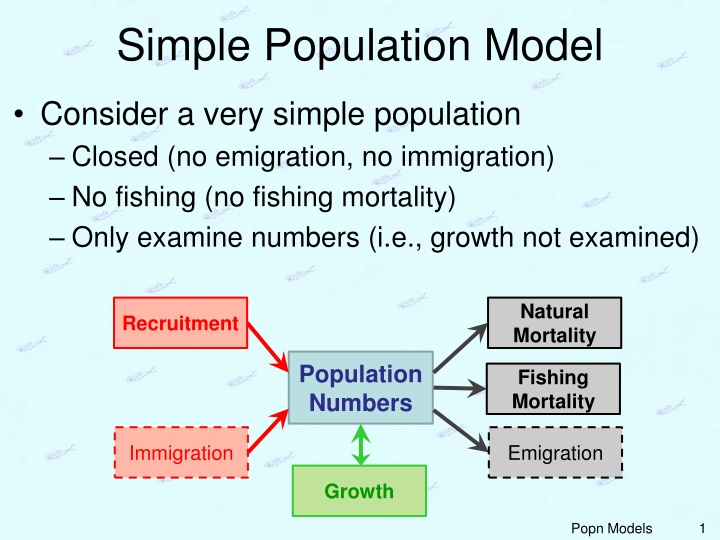
Simple Population Models and Population Dynamics
Explore the concepts of simple population models, population numbers, natural mortality, recruitment, and their implications on population dynamics. Delve into the realistic scenarios of population growth with varying values of the intrinsic rate of increase (r) and investigate more complex population models for a deeper understanding.
Download Presentation

Please find below an Image/Link to download the presentation.
The content on the website is provided AS IS for your information and personal use only. It may not be sold, licensed, or shared on other websites without obtaining consent from the author. If you encounter any issues during the download, it is possible that the publisher has removed the file from their server.
You are allowed to download the files provided on this website for personal or commercial use, subject to the condition that they are used lawfully. All files are the property of their respective owners.
The content on the website is provided AS IS for your information and personal use only. It may not be sold, licensed, or shared on other websites without obtaining consent from the author.
E N D
Presentation Transcript
Simple Population Model Consider a very simple population Closed (no emigration, no immigration) No fishing (no fishing mortality) Only examine numbers (i.e., growth not examined) Natural Mortality Recruitment Population Numbers Fishing Mortality Immigration Emigration Growth 1 Popn Models
Simple Population Model Define the following: Nt = Population size (numbers) at time t N0 = Initial (time=0) population size b = Per capita recruitment (birth) rate d = Per capita mortality (death) rate Population Numbers Natural Mortality Recruitment b d Nt 2 Popn Models
Simple Population Model Population Numbers Natural Mortality Recruitment b d Consider this Draw this 3 Popn Models
Simple Population Model Population Numbers Natural Mortality Recruitment b d Now consider this And draw this 4 Popn Models
Simple Population Model Population Numbers Nt Natural Mortality Recruitment b d Define the following: bNt dNt Construct a model for estimating Nt+1 from Nt Construct a model for estimating Nt from N0 5 Popn Models
Simple Population Model What is r? What are the population dynamics if r = 0 r > 0 r < 0 Are these dynamics realistic? Why? 6 Popn Models
More Complex Population Model If not realistic Then what is 7 Popn Models
More Complex Population Model Consider this Draw this 8 Popn Models
More Complex Population Model Sketch this (assume low N0) Consider this 9 Popn Models
More Complex Population Model Define equation for r Substitute into exponential growth model and simplify 10 Popn Models
Continuous Models Discrete models assume annual change Suppose there are n changes per annum Period rate of change becomes r n Total periods becomes nt Thus, Nt = N0(1+ r nt n) What happens to this model as n Substitute x= n r then let x 11 Popn Models
Continuous Models rt Thus, the continuous analogue is Nt = N0e Can also derive from ?N integration ?t= rN through Thus, r is the instantaneous per capita rate of change A rate of change at a particular moment Rate of change on the natural log scale Generally not interpretable Will often convert to annual rates of change 12 Popn Models
Density Independent Popn Growth Rate of change does not depend on population size (i.e., density) 13 Popn Models
Density Dependent Popn Growth Rate of change does depend on population size (i.e., density) 14 Popn Models
Density Dependent Popn Growth Rate of change does depend on population size (i.e., density) but not always in a linear fashion 15 Popn Models
